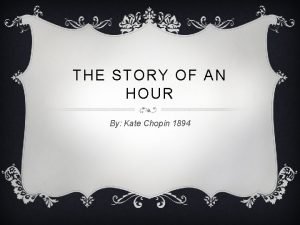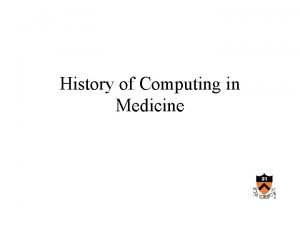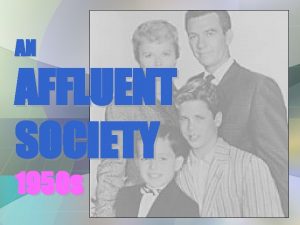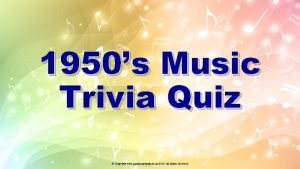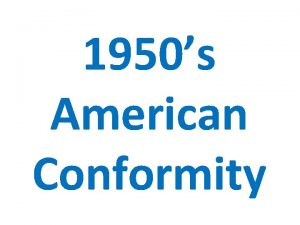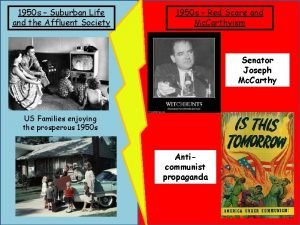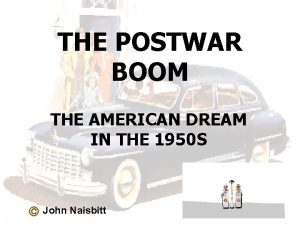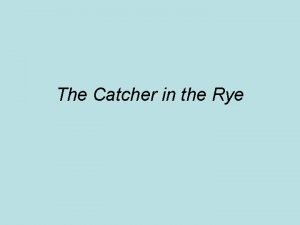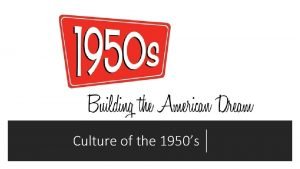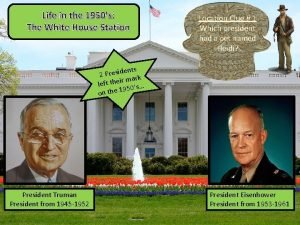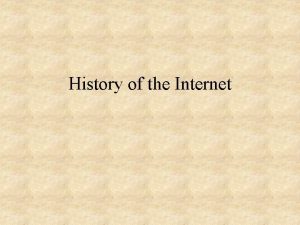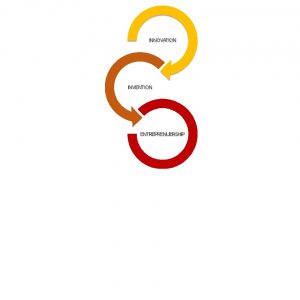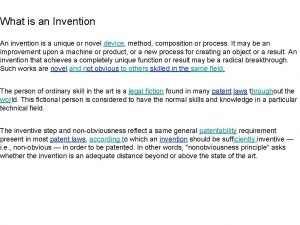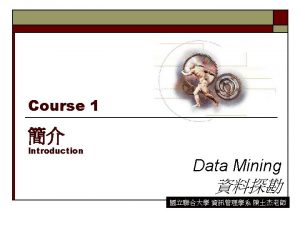History of the Internet Origins Late 1950s invention














- Slides: 14

History of the Internet

Origins • Late 1950’s: invention of the modem: modulator-demodulator or digital to analog • ARPA (Advanced Research Projects Agency) formed in 1958. • ARPA created to bolster national defense, but also as a way to carry out open ended research. (Eisenhower believed in science. )

The Development of Ideas. • Joseph Licklider conceived the vision for the Internet: he researched time-sharing, so that several users could access one computer. He also contacted universities and research centers to interest them in connecting all of their computers. • In the 1960’s, Ted Nelson developed the idea of hyperlinks.


Early Innovations • In 1964, American Airlines develop SABRE, the first computerized Airline Reservation System. • In 1969, ARPAnet, the first multicomputer network was created. There were four sites: UC-Santa Barbara, UCLA, SRI International, and the University of Utah. By 1971, 19 other sites have joined.

Early Internet • In 1971, the first e-mail is sent with a program called CPYNET (“copynet”). • In 1972, ARPAnet exhibited at International Conference on Computer Communications. • In 1973, PLATO was developed which is an early model for threaded online discussions. Talkomatic/Personal Notes/Group Notes • In 1975, the MITS Altair 8800 first personal computer is invented and sold.

Internet reaches the Public • In 1975, news stories lead to the public having general knowledge of the ARPAnet. • In 1978, the first message bulletin board system is created. • In 1979, first MUD (multiuser dimension or multiuser domain or multiuser dungeon) is created at Essex University, which is linked to ARPAnet by 1980. (text only) • USENET created in 1979 by students at Duke and University of North Carolina. The resulting discussions are called “newsgroups. ”

Further Advancements • In 1981, Ted Nelson’s Xanadu. A hypertext database is developed (but never marketed), but creates the basis for the web. • In 1984, the Apple Macintosh debuts with a graphical interface. (Xerox PARC)

Modern Internet I • By the late 1980’s, the Internet had 60, 000 members, still mostly associated with the military, college or corporations. • In 1986, NSFnet is created (National Science Foundation) to help college and research institutions without the funds to be members of APRAnet. In 1989, there are over 100, 000 sites. • Internet worm released at Cornell by Robert Morris to attack Sendmail. Duplicates itself on computers and crashes 10% of computers connected to internet.

Modern Internet II • In 1983, Fido. Net (a BBS) spreads the popularity of BBSs and bring networking to elementary and secondary schools. Freenets (first in Cleveland) are accessible to anyone with computer and modem. Provides e-mail, discussion boards, chat, and local information • The Well (Whole Earth ‘Lectronic Link: “You own your own words. ”) and AOL were formed as BBSs. AOL was meant to be easy from the start.

The Web is Weaved • In 1991, Tim Berners-Lee, at the European Laboratory for Particle Physics, created HTTP (hypertext transfer protocol), HTML (hypertext markup language) and URL (universal resource location). The whole system was named the world wide web. • Commercial traffic could use the Internet, but the Internet couldn’t “come to them. ” The acceptable use policy is modified in 1992. By 1995, the NSFnet is dissolved as commercial networks take over most of the Internet traffic.

Internet Tools • Gopher (1992) allows users to search for information, creating an index of sources. But, the web is quickly preferred. • As the web takes off, browsers are written. The first were called Erwise, Midas, Cello, etc. . These led to Mosaic, which led to Netscape and Internet Explorer. (Now: Mosaic is back, as is Macintosh’s Safari. )

Early Web • In 1994, World Wide Web Consortium is created to promote web. (standards and specifications) • In 1994, shopping malls, banks, and radio stations all come to the web. Yahoo! is created. • In 1997, AOL loses a class-action suit after offering unlimited internet access and not able to meet expectations (busy signals and crashes). • Late 1990’s: start-up web companies.

How It Works Now • Loose organization of networks. • Government still pays for some of the backbone. There is an Internet 2 for use by some universities (very fast. ) • ISP (Internet Service Providers) provide monthly internet access.
 Color tv started
Color tv started 1950s home economics textbook
1950s home economics textbook Computers in the 1950
Computers in the 1950 Beaniks
Beaniks Concept cars of the 1950s
Concept cars of the 1950s The affluent society 1950s
The affluent society 1950s 50s music trivia questions and answers
50s music trivia questions and answers 1950s conformity examples
1950s conformity examples Suburban life 1950s
Suburban life 1950s 1950s conformity and counterculture
1950s conformity and counterculture How were conglomerates and franchises alike and different
How were conglomerates and franchises alike and different Catcher in the rye 1950s culture
Catcher in the rye 1950s culture Pop culture of the 1950s
Pop culture of the 1950s Mass media in the 1950s
Mass media in the 1950s White house 1950s
White house 1950s

